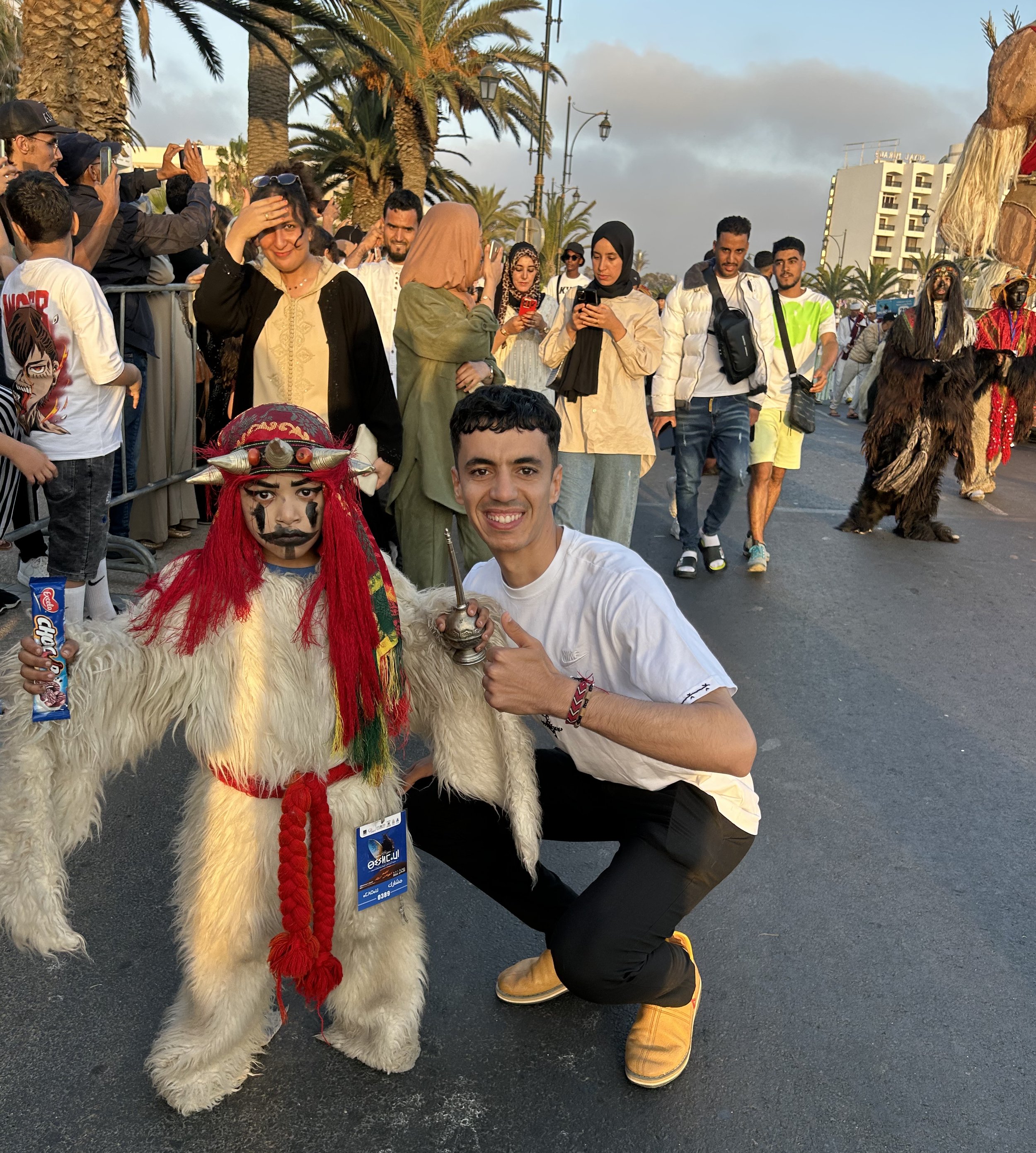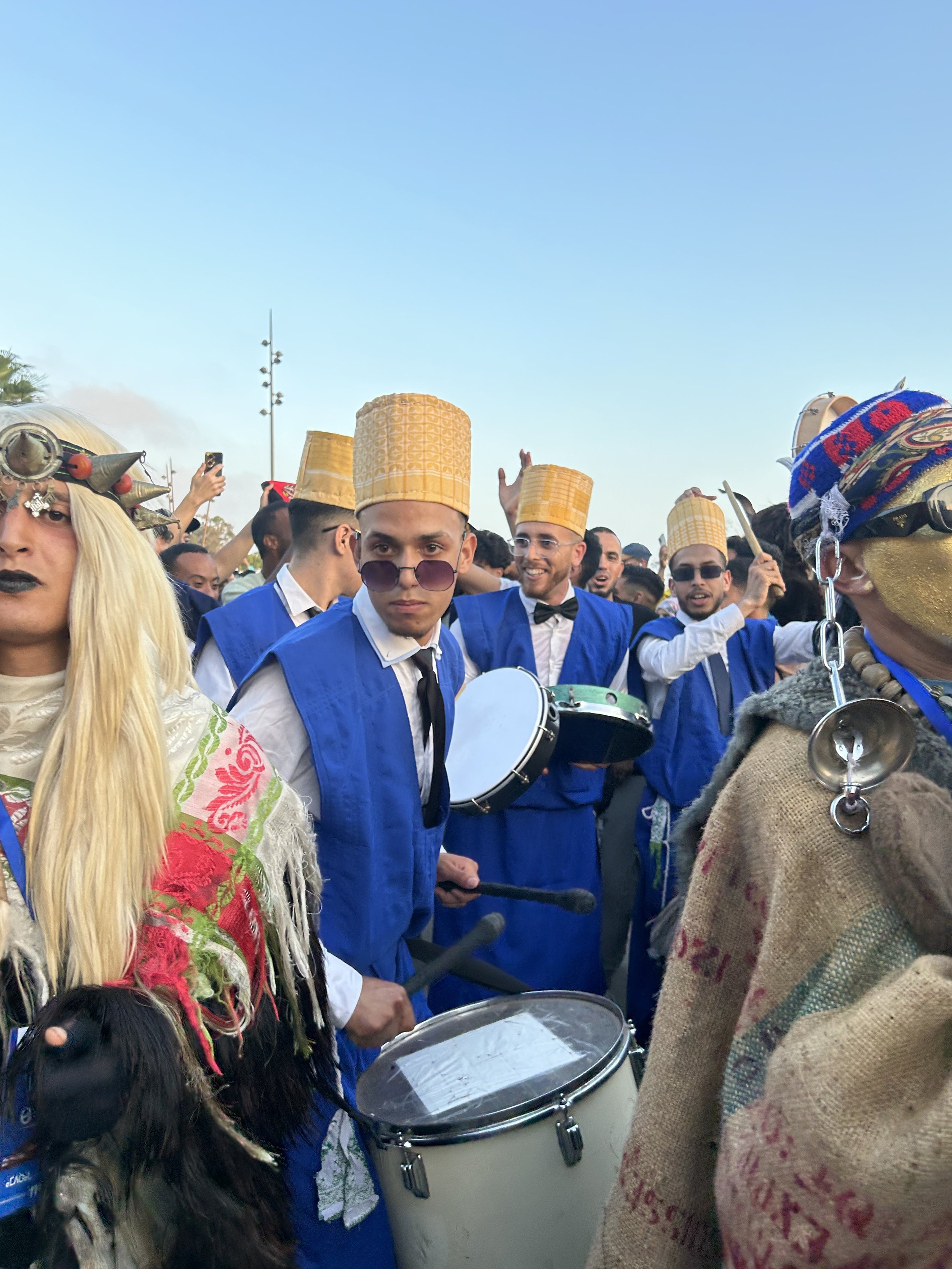Blog #3.27 A Night of Culture Immersion in Agadir: The Bilmawn/Boujloud Festival
Parade floats in Bilmawn procession
As our time in country comes to an end, I have been in deep reflection about the experiences that enriched the time we have spent in Morocco. Cultural immersion was an inevitable part of our time engaging in research and working in local communities here, but I am especially amazed by the breadth and depth of the experiences I’ve had in such a short time. In the company of my fellow American student researchers, and with the familiarity and generosity of our Moroccan speaking partners, I’ve had the privilege to experience Moroccan culture and its communities in ways beyond what I would have been able to on my own. One specific instance that made for one of the most memorable days here in Agadir happened during our first full week in-country. In this blog entry, Rachid and I reflect on that experience as an Amazigh and as a guest of the culture.
Our first week in Morocco overlapped with a three-day-long celebration in early July after Eid al-Adha called the Bilmawn festival. Our field school coordinator, Noura informed us of the festival and recommended that we attend the festivities as it was a serendipitous opportunity to experience Moroccan and Amazigh traditions..
History of the Festival
The Bilmawn festival, also known as the Boujloud festival (in Arabic) is a traditional celebration in Morocco that coincides with the Islamic holiday of Eid al-Adha. The festival is particularly famous in the region of Souss-Massa, including the city of Agadir. During Bilmawn, participants dress in elaborate costumes made from animal skins and masks, often resembling goats or other creatures. These costumes are used to celebrate and symbolize various aspects of Moroccan culture and folklore. The festival includes music, dancing, parades, and theatrical performances, creating a vibrant and communal atmosphere. Bilmawn has roots in pre-Islamic Amazigh traditions and has evolved over time, incorporating Islamic elements and local customs. It is a unique cultural event that showcases Morocco's rich heritage and the blend of ancient and contemporary practices.
A float that we saw during the parade processions. Ezzouhra shared that these were handmade by groups of parade members representing their communes and villages.
Rachid’s Impression of the Festival as an Amazigh
Attending the Bilmawn festival was a profound experience, revealing the deep connections and communal joy that define Moroccan culture. Accompanying American students to the festival added another layer of meaning, as their appreciation and enjoyment of the event made me immensely proud of my heritage. The vibrant atmosphere, where strangers become friends through dance and shared celebrations, underscores the power of tradition in fostering unity.
Ezzourha and Isabelle helping a parader adjust their wig, a vital part of the costume!
The intricate costumes, each crafted with care, reflect the dedication and pride participants display in their heritage. Seeing people from diverse backgrounds come together, united by music and dance, highlights the festival's role in breaking down social barriers and creating a sense of belonging. Introducing the American students to this celebration was particularly rewarding. Their enthusiasm and admiration for the festival demonstrated the universal appeal of Moroccan traditions. When we found ourselves in the parade, I felt truly immersed in my culture. This deep immersion, being part of the lively procession, allowed me to experience the rich, vibrant essence of our traditions.
This celebration of life, culture, and community is a testament to the enduring spirit of Moroccan traditions, reminding us of the importance of preserving and cherishing our cultural heritage. The Bilmawn festival not only showcases the beauty of Moroccan customs but also demonstrates how cultural events can strengthen social bonds and create lasting memories.
Melissa’s Impressions of the Festival as a Foreigner
I decided to join on the final day of the festival, during the parade. It’s path came down a main street that was minutes from where we were staying in downtown Agadir and ending just steps away from Agadir beach. Ezzouhra, and Rachid -- two of our speaking partners-- joined Isabelle and I in finding and following the parade processions. I expected to find a place in the crowd with a clear enough view of the procession of people donning traditional garb and carrying their handmade parade floats. What actually happened was the epitome of the phrase “you just had to be there”.
Ezzhoura and Rachid helped Isabelle and I weave through the crowd of spectators in attempts to get a clear view. Ezzhoura, Isabelle and I snaked through the crowd holding hands so we wouldn’t lose each other while Rachid and Ezzhoura took turns parting the crowd, bringing us closer and closer to the first row. Both Ezzourha and Rachid were insistent that there was a better vantage point ahead whenever we briefly stopped and Isabelle and I happily obliged. Before long, we found a place within the first row, steps away from the parade’s procession.
As I took in the prime view, members of the parade donned in their goat skin costumes or in their coordinated traditional outfits approached us, danced alongside us, playing their instruments and breaking into song and chant as they marched onward down the street. Every few minutes a new set of parade processioners passed us and a new song or chant was introduced. The crowd behind us joined in clapping and chanting along. The polyphony of sound included screams of excitement from children and teens running alongside the parade to snap photos next to some of the best-costumed paraders. Eventually we decided to chase the paraders too. We ended up marching directly alongside them and becoming part of the parade!
I felt euphoric, as the hand drums carried a rhythm that mirrored the pace of the parade march, and instruments that looked like finger cymbals chimed enriching the sounds of and sights of the parade. We followed the parade all the way to its end. I was in awe of the intricacies of the costumes the floats and the creativity of the costumes we say. But the music, its improvisational nature and the dynamism of the crowd all along the parade path is what made the biggest impression on me. To me, it spoke to how ingrained the Bilmawn festival was for both the parade participants and its spectators. It felt like the music was part of them and it showed, as one chant seamlessly transitioned to the next for at least two hours. Experiencing the Bilmawn festival gave me a window into the culture and traditions of Morocco that I hope will be etched forever into my memory. At the very least, this experience will have a permanent place in my digital archive of photos and videos so I can relive them long after we have left Morocco.
-By Melissa Eustache, MA student in Applied Anthropology at USF









